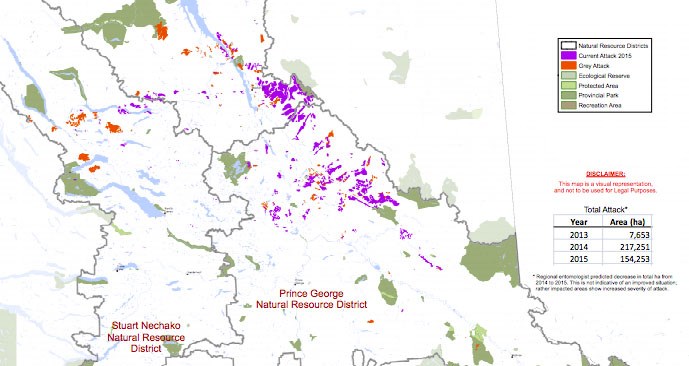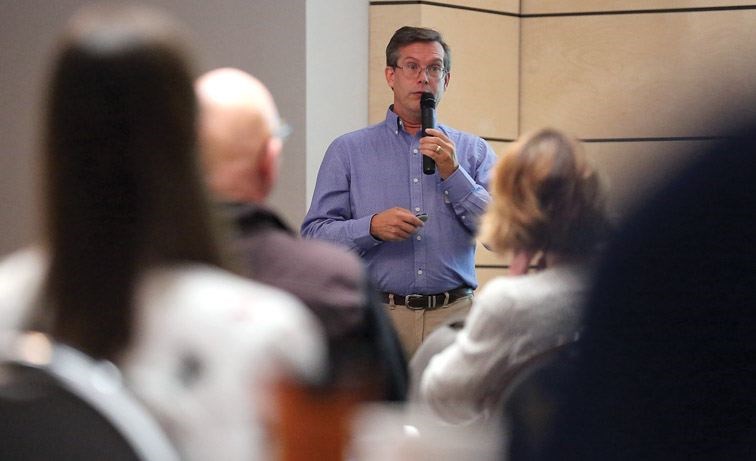About a third of this year's spruce beetle larvae are expected to mature a early, adding their number to the outbreak as next year's crop takes flight in the spring.
Most of the spruce beetle in the Omineca region - about 85 per cent - typically follow a two-year life cycle, said Robert Hodgkinson, a 35-year forest entomologist who returned from retirement to lend expertise to the Ministry of Forests & Natural Resource's efforts to fight the beetle.
But an early warm spring meant the beetles took flight in mid-May rather than early June, giving them time to move through larvae stages and progress to adulthood before this winter.
"It's the earliest I've ever seen it in this region," said Hodgkinson before a packed room of about 100 people taking part in a two-day summit on spruce beetle management. "That complicates our life because we're going to have a larger flight next year of these one-year beetles from 2016 flying on top of the two-year cycle that attacked trees in 2015."

The uptick is further complicated by a 35 per cent increase in damaged forest in 2016 over the year before, according to data released by the ministry Wednesday.
Aerial surveys over the summer of the Omineca region showed 210,000 hectares of forest damaged by the bug, up from 156,000 in October 2015.
Prince George was by far the most heavily hit, its 137,000 hectares make up 65 per cent of the beetle-affected area, while the remainder was within the Mackenzie district.

Licensees like Canfor have to balance a list of factors when addressing infested trees, like wildlife conservation, old growth management, riparian retention, fishery sensitive watersheds, harvest restriction in areas associated with the woodland caribou and more.
"We're in much more complicated areas. There are a lot of other non-timber values in areas where we're seeing the spruce beetle," said Sara Cotter, a planning coordinator for Canfor who spoke from the industry perspective.
"Patch cuts, strip cuts, clear cuts, we've been considering ways to practice alternative silvicultural strategies so that we can deal with the beetle infestation in some areas," she added.
Using "trap" trees is still the favoured approach as one of the most economically efficient options. The beetles are shade-loving bugs and are 10 times more likely to infest blowdown over standing trees - a departure from the mountain pine beetle, which typically targeted upright stands.
A felled trap tree can suck up enough beetles to save as many as eight to 10 standing trees, Hodgkinson estimated.
Other proactive approaches include cutting stumps as low as possible and addressing long butts in unburned cull piles.
"Good housekeeping is necessary," he said.
Cotter said she hoped new technology could help the problem, but it often isn't fast enough to keep up with the spread.
The infected trees are notoriously difficult to detect and can take anywhere from a year to 18 months before the symptoms become visible in the forest.
"It's a long delay before anything is noticeable from the air at least with the visible eye and then it's a very short, rapid decline after that," Hodgkinson said.
Last year Canfor used photo and mapping technology to track the infected trees, but by the time they got "boots on the ground" six months later the beetle was already gone.
"It's always worth checking out to see if some of the technology can speed up our actions but at this point in time I'd have to say that one didn't work out as well as we were hoping," said Cotter, who also noted getting to the outbreak area can be a problem if there are poor access roads or restrictions on entering an environment.
Cotter said about 52 per cent of the volume Canfor feeds to local mills is from spruce beetle damaged areas but said estimating the volume can be tricky.
The harvest window is also shorter for spruce beetle. While mountain pine beetle affected trees can be harvested for up to 15 years, the economic life span of a spruce beetle affected tree is only three to five years.
"It doesn't give you a lot of time to get into areas that are so tough to access."
The summit continues Thursday at the Ramada hotel.


